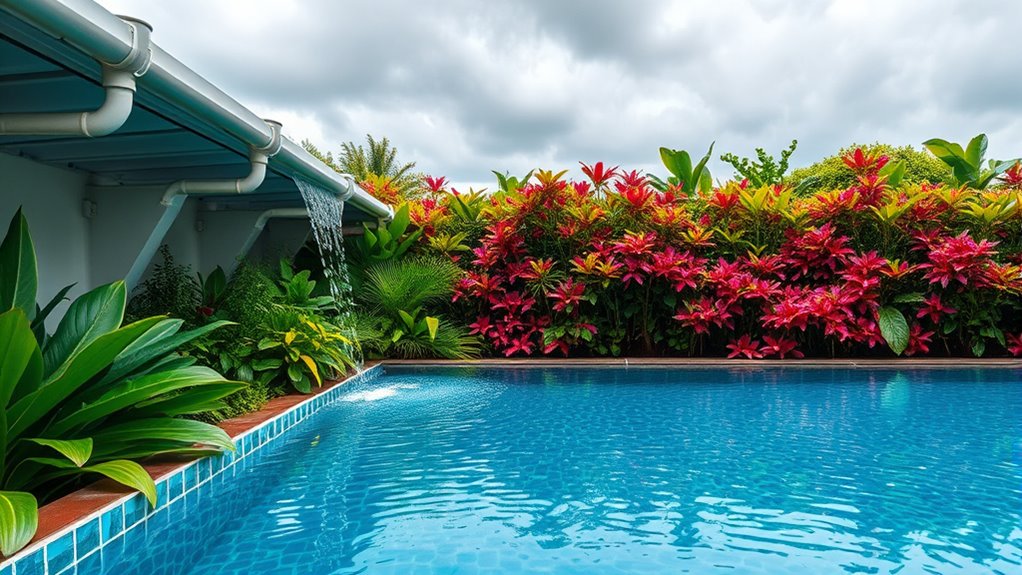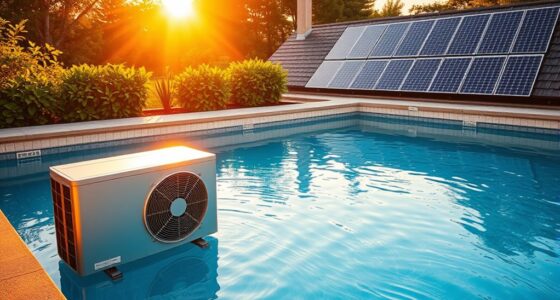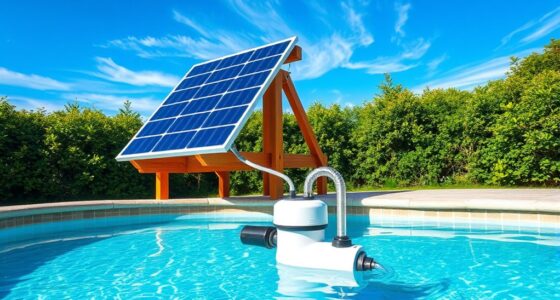Implementing rainwater harvesting for your pool is an eco-friendly way to cut water costs and reduce your environmental impact. By capturing runoff from your roof and filtering it properly, you can enjoy cleaner, healthier water with fewer chemicals and less reliance on treated tap water. Regular maintenance guarantees your system stays efficient and safe. Continuing with this approach helps conserve local water resources, especially during droughts—discover more ways to make your pool sustainable.
Key Takeaways
- Rainwater harvesting reduces reliance on municipal water, lowering costs and supporting eco-friendly pool management.
- Effective filtration systems ensure rainwater is clean, safe, and requires fewer chemicals for pool maintenance.
- Proper setup captures runoff from roofs, directing it into storage tanks with filters to prevent contamination.
- Regular system maintenance, including filter replacement and tank inspections, maintains water quality and system efficiency.
- Using harvested rainwater eases strain on local water resources, especially during droughts, promoting sustainable practices.

Ever wondered how you can reduce your pool’s water costs while helping the environment? Rainwater harvesting offers an excellent solution. Instead of relying solely on municipal water supplies, you can collect and use rainwater for your pool, cutting back on water bills and conserving a precious resource. The key is understanding how to implement rainwater filtration effectively so the water you use remains clean and safe. Proper rainwater filtration involves filtering out debris, leaves, and dirt before the water reaches your pool. This process minimizes the amount of maintenance needed and helps keep your pool sparkling without excessive chemical use. When you start harvesting rainwater, you’ll want to set up a system that captures runoff from your roof or other catchment areas, directing it into storage tanks. From there, a reliable filtration system ensures the water is free from contaminants, making it suitable for pool use. This way, you’re not just saving money; you’re also reducing your environmental footprint by decreasing your reliance on treated tap water. Additionally, understanding rainwater quality helps ensure your harvested water remains safe and suitable for pool use.
Using rainwater for your pool requires some initial setup, but it pays off long-term. Regular pool maintenance becomes easier because you’re often working with cleaner, less chemically-treated water. You’ll need to check your filtration system regularly to guarantee it’s functioning properly and replace filters as needed. Additionally, maintaining the overall health of your rainwater harvesting system involves inspecting gutters, tanks, and filters to prevent algae growth, mosquito breeding, or sediment buildup. By doing so, you ensure your rainwater remains safe and clear, reducing the chances of algae or bacteria developing in your pool.
Incorporating rainwater into your pool maintenance routine isn’t just about saving money—it’s about adopting a sustainable lifestyle. When you use harvested rainwater, you help ease demand on local water resources, especially during dry seasons or droughts. Plus, it’s an eco-friendly way to keep your pool pristine without constantly increasing your water bills. Just remember, the key to success lies in properly filtering rainwater before it enters your pool. This ensures the water stays clean and reduces the need for harsh chemicals, which is better for your health, your pool equipment, and the environment. With the right setup and regular upkeep, rainwater harvesting becomes an efficient, eco-conscious method to enjoy your pool while making a positive impact on the planet.
Frequently Asked Questions
What Are the Initial Costs of Setting up Rainwater Harvesting Systems?
The initial costs of setting up rainwater harvesting systems typically range from $1,000 to $5,000, depending on your project’s size and complexity. Your cost estimation should include installation expenses, such as gutters, filters, storage tanks, and pumps. Keep in mind that higher-quality materials or larger capacity tanks will increase costs. Planning carefully helps you stay within budget while ensuring an efficient, eco-friendly system for your pool water needs.
How Much Maintenance Is Required for Rainwater Harvesting for Pools?
Think of your rainwater harvesting system as a garden needing constant care. You’ll need to perform regular system maintenance and filter cleaning to keep the water pure and the system running smoothly. Typically, check filters monthly and clear debris from gutters. While it’s not overly demanding, consistent upkeep guarantees your pool’s water stays fresh, eco-friendly, and ready whenever you need it. Proper maintenance makes all the difference.
Can Rainwater Harvesting Fully Replace Traditional Pool Water Sources?
You can’t fully replace traditional pool water sources with rainwater harvesting, but it’s a great alternative water source. Rainwater quality varies depending on your location and collection methods, so you’ll need filtration and treatment to guarantee safety. While it reduces reliance on municipal water, supplementing with other sources ensures your pool stays clean and healthy, especially during dry or low-rain periods.
Are There Legal Restrictions for Rainwater Harvesting in Certain Areas?
Legal restrictions on rainwater harvesting are like guardrails guiding your efforts. You might need permits or face restrictions depending on your area, as laws vary widely. Some regions encourage it, while others have strict rules to protect water rights. Before you start, check local regulations and permit requirements to stay compliant. Ignoring these rules could lead to fines or project delays, so always do your homework first.
How Does Rainwater Harvesting Impact Overall Pool Water Quality?
Rainwater harvesting can improve your pool water quality by reducing reliance on chemicals and lowering contaminants. You should guarantee proper water filtration to remove debris and sediments, and regularly check the chemical balance to prevent algae growth and maintain safe conditions. Using harvested rainwater minimizes mineral buildup and reduces chemical use, resulting in clearer, healthier water. Proper maintenance ensures your pool stays clean and eco-friendly, maximizing the benefits of rainwater harvesting.
Conclusion
By harnessing rainwater for your pool, you’re not only saving money but also helping the environment. Did you know that a typical rainstorm can provide enough water to fill a standard pool in just a few hours? Embracing rainwater harvesting makes your pool eco-friendly and sustainable. Start implementing these simple systems today, and enjoy the benefits of responsible water management while reducing your environmental footprint. It’s a smart choice for your pool and our planet.









